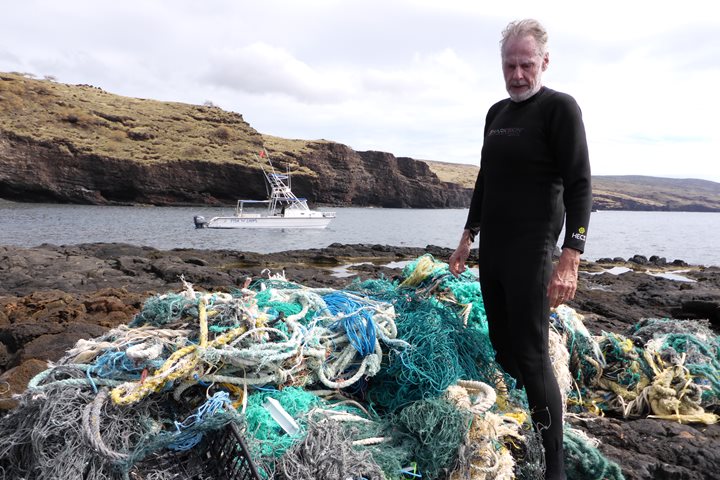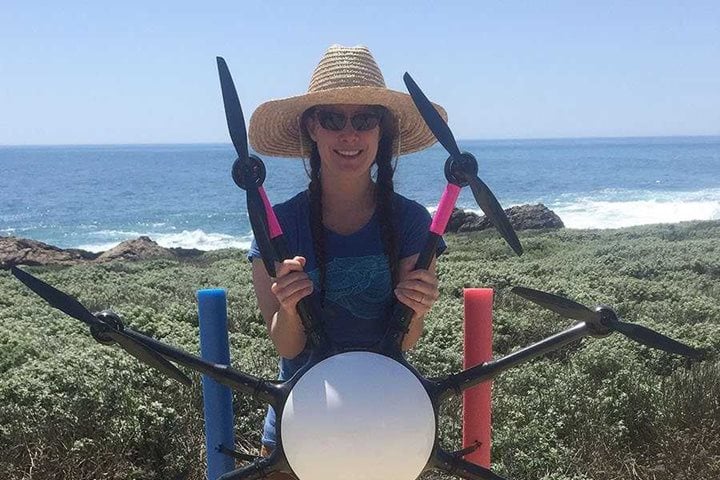Call +1.800.397.3348 or contact your travel advisor
- WorldView
- 6 Min Read
- 25 Feb 2019
Executive Chef Lothar Greiner On Creating a Moveable Feast
Lothar Greiner has served up 15,000 meals a day on large cruise vessels and he’s owned a restaurant in New Zealand, but his most satisfying role has been in small-ship expedition travel. During his 14 years aboard the M.V. Orion—which in 2011 became the National Geographic Orion—Lothar has explored some of the most remote places on the planet. “To this day I find it fascinating to wander the markets near port, talking with local people, farmers, or fishermen—whether in Europe, on a Pacific island, in the jungles of Borneo, or the highlands of Papua New Guinea.” Chef Lothar took time from his very busy day to share what it’s like to orchestrate a moveable feast aboard ship. Get Inspired By Photos, Videos, Webinars, Stories, And Exclusive Offers. Sign Up
Chef Lothar goes in search of lamb in the Falkland Islands.
What is it like to provision food in the kind of remote places where we explore?It can be challenging but over the years we have made reliable contacts, even in the most remote corners of the planet, where there is always something I can buy and turn into a delightful meal for our guests.
For example, in the Falklands I head a few times a season to Carcass Island to Rob and Lorraine McGill’s farm (fun fact: they are the only year-round residents of the island!) to get some beautiful spring lambs, which graze in a pristine coastal environment. On Carcass we also top off our fresh supplies—tomatoes, green beans, cucumbers, capsicums, a variety of lettuces and potatoes, even strawberries—all grown in hot houses by another one of our vendors located there.
In other regions I’ve perused local markets, climbed trees to get breadfruit, or chopped bunches of bananas off with machetes handed to me by the locals. I’ve learned to always take a bag with me as I inevitably find something along the way. In the South Pacific I might pick fresh limes for an evening appetizer of poisson cru, or return with banana leaves on my back and a bag of carambola (starfruit) and juicy pomelos.
On a voyage to Iceland Chef Lothar went foraging for this fresh and fragrant thyme.Not everyone might associate expedition travel with superb dining. What are some of the culinary highlights our guests can expect on board?Along with offering our guests the best of what there is to see and do in the regions we visit, we also like to provide our guests with the luxury of the best possible services on board—and that includes some pretty excellent food. Our guests are amazed at how it is possible to have all these fresh vegetables and fruits still available after a week, or sometimes even after 20 days.
Orion is currently in Antarctica where our guests can enjoy a gourmet “Antarctic Blue” dégustation menu, paired with selected wines by our onboard sommelier. We have a range of fantastic wines from Chile, Argentina, New Zealand, Australia, California, Oregon, as well as France, Spain, and Italy. We also serve a South American dinner consisting of specialties from Ecuador, Peru, Chile, Argentina and Brazil, again accompanied with local wines. Some mornings, weather permitting, we’ll set up on the deck and treat guests to a traditional German Frühschoppen—Bratwurst on a crusty bun, Bloody Marys, beers and split pea soup—accompanied by cool jazz or German Blasmusik in the background and a backdrop of towering icebergs, frolicking whales, and darting penguins.Click here to get the recipe for Chef Lothar's Triple Chocolate Semifreddo.
Cooking is serious business for Chef Lothar (second from right) and his team on the Orion!
Tell us what it’s like to cook when the weather gets rough. We have been through some “weather” indeed, however, in my 14 years aboard Orion I’ve only had to say twice to my team, “we all have to leave the galley now!” We have a lot of experience on how to work on board and what to watch out for when the going gets tough. The benches are topped with nonslip materials, so nothing can slide around. We pay careful attention that our knives are always secured. Stoves are fitted with frames to keep pots and pans secured, and so on. During these rough times we have to stay focused and alert, securing moveable equipment like trolleys with rope.
Chef Lothar takes advantage of a rare break from work to go diving in French Polynesia.Do you have any favorite moments from a voyage when you got to explore off ship? A lot of my time off the ship is spent in markets, but I like being in the water, going on hikes, and more if the workload allows it. One of my most memorable moments would be climbing a steep mountain with ropes and a harness in the Norwegian fjords, and then riding down to the bottom on a mountain bike. Then there’s diving with hundreds of sharks and snorkeling with 20 playful manta rays in French Polynesia. And in Borneo I used to travel up the Kumai River for three hours to deliver canapés to our guests who were returning back to the ship after visiting orangutans deep in the jungle. On the way back it would be twilight. Noise from the jungle would change from birds to cicadas and the trees would light up with fireflies “switching on and off” in unison as I rode into the sunset—amazing!
Stopping for a fun photo op with Orion in Neko Harbor, Antarctica.
Describe what a typical day on board is like for you. My day consists primarily of planning and overseeing preparations for breakfast, lunch, afternoon tea, and dinner for not only guests but all our officers, staff, and crew. I do my share of administration such as uploading menus to the web, responding to emails, and having discussions with the Hotel Manager, Pastry Chef, Garde Manger, and Provisions Master to ensure menu variety and consistency in our supply chain. There are also more meetings, quality control, and interacting with guests to ensure they are happy and enjoying their experience. I begin my day at 6 a.m., sometimes earlier, and finish with a final galley check at 10 p.m. In between, it’s important to find time to visit the gym for a treadmill run. After the day is done, I wind down in the lounge chatting to guests.
When you’re not working what do you enjoy cooking for yourself?Usually simple things, fresh fish from the local market, and vegetarian meals, as my wife is a pescatarian and doesn’t eat meat. Depending what season it is back home I might treat myself with a hearty stew, a recipe from my childhood and my mum’s cooking back home in the Black Forest, Germany.
Get a taste of Chef Lothar's work when you travel aboard National Geographic Orion to Antarctica, South Pacific, or the Russian Arctic.



